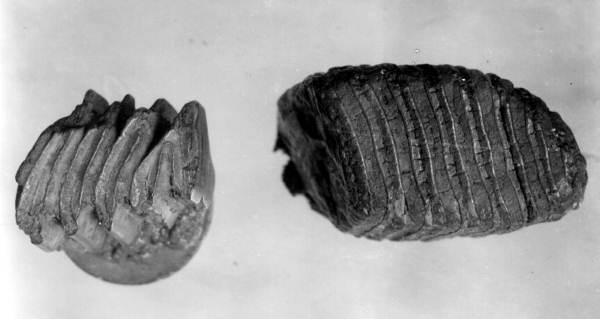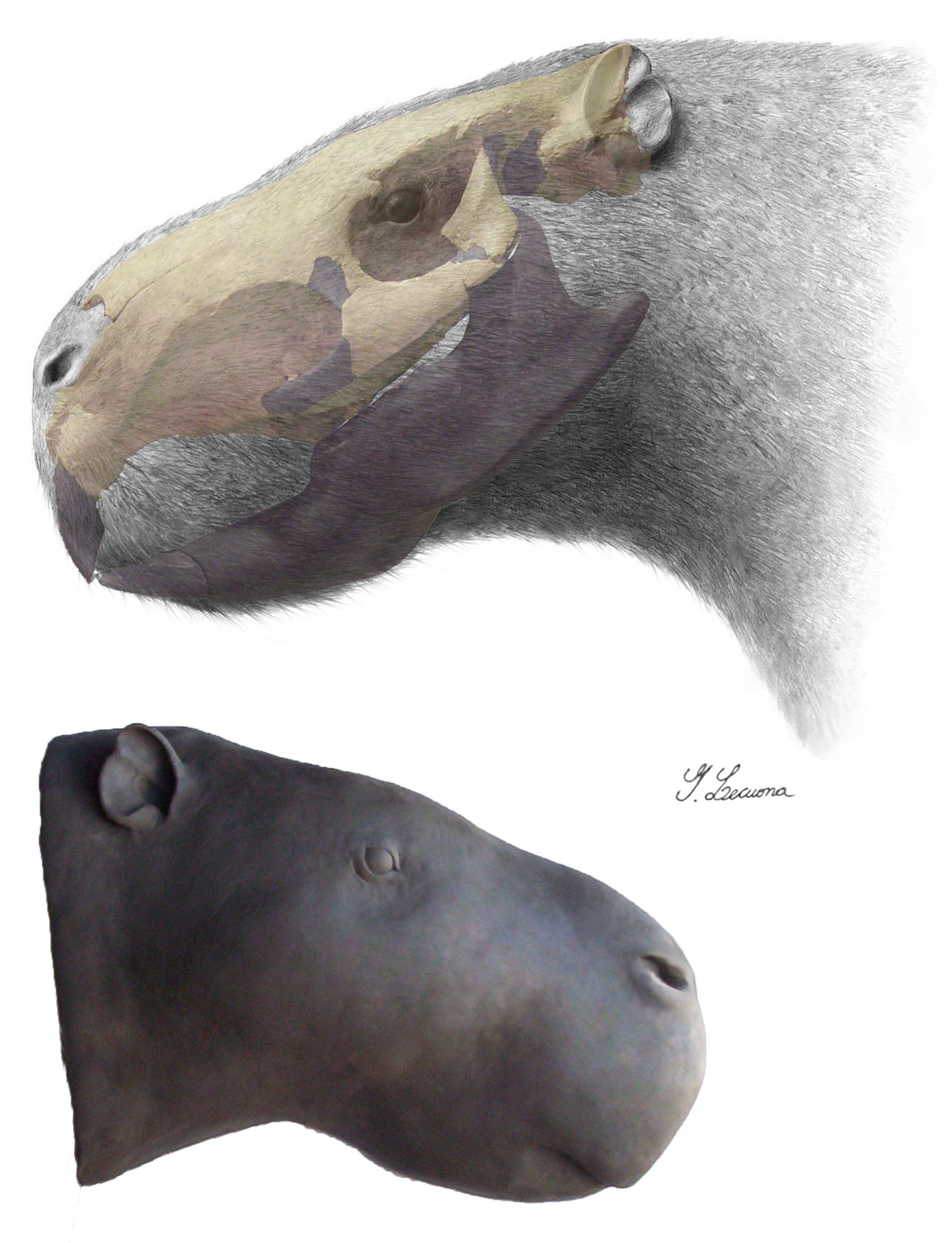|
Dinomyidae
The Dinomyidae are a family (biology), family of South American hystricognath rodents: the dinomyids were once a very speciose group, but now contains only a single living species, the pacarana. Several of the extinct dinomyids were among the largest rodents known to date; these included the bison-sized ''Josephoartigasia monesi'' and the smaller ''Josephoartigasia magna''. The dinomyids are thought to have occupied ecological niches associated with large grazing mammals due to their ability to compete with the Meridiungulata, native ungulates of South America. On the other side, they could feed on aquatic or swampy plants along the ancient rivers. These large forms disappeared after the formation of a Great American Interchange, connection to North America. The modern pacarana is only modest in size, considerably smaller than the capybara. The Neoepiblemidae, an entirely extinct family, may actually be part of the Dinomyidae; both groups are undoubtedly closely related. Genera ... [...More Info...] [...Related Items...] OR: [Wikipedia] [Google] [Baidu] |
Josephoartigasia
''Josephoartigasia'' is an extinct genus of enormous Dinomyidae, dinomyid rodent from the Early Pliocene to Early Pleistocene of Uruguay. The only living member of Dinomyidae is the pacarana. ''Josephoartigasia'' is named after Uruguayan national hero José Artigas. It contains two species: ''J. magna'', described in 1966 based on a left mandible, and ''J. monesi'', described in 2008 based on a practically complete skull. Both are reported from the San José Member (geology), Member of the Raigón Formation by the Barrancas de San Gregorio along the shores of Kiyú – Ordeig, Kiyú beach. The skull of ''J. monesi'' measures , similar to a beef cow skull, equating to a full body length of —though this is likely an overestimate—and a weight of about . This makes ''J. monesi'' the biggest rodent ever discovered. It was much larger than ''J. magna'' or the largest living rodent, the capybara, which averages . ''J. monesi'' also had a massive bite force of approximately at the i ... [...More Info...] [...Related Items...] OR: [Wikipedia] [Google] [Baidu] |
Josephoartigasia Monesi
''Josephoartigasia'' is an extinct genus of enormous dinomyid rodent from the Early Pliocene to Early Pleistocene of Uruguay. The only living member of Dinomyidae is the pacarana. ''Josephoartigasia'' is named after Uruguayan national hero José Artigas. It contains two species: ''J. magna'', described in 1966 based on a left mandible, and ''J. monesi'', described in 2008 based on a practically complete skull. Both are reported from the San José Member of the Raigón Formation by the Barrancas de San Gregorio along the shores of Kiyú beach. The skull of ''J. monesi'' measures , similar to a beef cow skull, equating to a full body length of —though this is likely an overestimate—and a weight of about . This makes ''J. monesi'' the biggest rodent ever discovered. It was much larger than ''J. magna'' or the largest living rodent, the capybara, which averages . ''J. monesi'' also had a massive bite force of approximately at the incisors (on par with large carnivores) ... [...More Info...] [...Related Items...] OR: [Wikipedia] [Google] [Baidu] |
Josephoartigasia Magna
''Josephoartigasia'' is an extinct genus of enormous dinomyid rodent from the Early Pliocene to Early Pleistocene of Uruguay. The only living member of Dinomyidae is the pacarana. ''Josephoartigasia'' is named after Uruguayan national hero José Artigas. It contains two species: ''J. magna'', described in 1966 based on a left mandible, and ''J. monesi'', described in 2008 based on a practically complete skull. Both are reported from the San José Member of the Raigón Formation by the Barrancas de San Gregorio along the shores of Kiyú beach. The skull of ''J. monesi'' measures , similar to a beef cow skull, equating to a full body length of —though this is likely an overestimate—and a weight of about . This makes ''J. monesi'' the biggest rodent ever discovered. It was much larger than ''J. magna'' or the largest living rodent, the capybara, which averages . ''J. monesi'' also had a massive bite force of approximately at the incisors (on par with large carnivores) and ... [...More Info...] [...Related Items...] OR: [Wikipedia] [Google] [Baidu] |
Pacarana
The pacarana (''Dinomys branickii'') is a rare and slow-moving Hystricognathi, hystricognath rodent indigenous to South America. Native Tupian languages, Tupi people call it the ''pacarana'' (false paca) because it is superficially similar to the paca, a different rodent which is not in the same family. The pacarana has a chunky body and is large for a rodent, weighing up to and measuring up to in length, not including the thick, furry tail. The pacarana is nocturnal and is found only in tropical forests of the western Amazon Basin, Amazon River basin and adjacent foothills of the Andes Mountains. It ranges from northwestern Venezuela and Colombia to western Bolivia, including the Yungas. It is common in Cotapata National Park and Integrated Management Natural Area, Cotapata National Park in Bolivia. The pacarana is the monotypic, sole extant member of the rodent family Dinomyidae in the Order (biology), infraorder Caviomorpha; the paca that it resembles in appearance is in a d ... [...More Info...] [...Related Items...] OR: [Wikipedia] [Google] [Baidu] |
Dinomys
The pacarana (''Dinomys branickii'') is a rare and slow-moving hystricognath rodent indigenous to South America. Native Tupi people call it the ''pacarana'' (false paca) because it is superficially similar to the paca, a different rodent which is not in the same family. The pacarana has a chunky body and is large for a rodent, weighing up to and measuring up to in length, not including the thick, furry tail. The pacarana is nocturnal and is found only in tropical forests of the western Amazon River basin and adjacent foothills of the Andes Mountains. It ranges from northwestern Venezuela and Colombia to western Bolivia, including the Yungas. It is common in Cotapata National Park in Bolivia. The pacarana is the sole extant member of the rodent family Dinomyidae in the infraorder Caviomorpha; the paca that it resembles in appearance is in a different Caviomorph family, the Cuniculidae. Initially, the pacarana was regarded as a member of the superfamily Muroidea, that inclu ... [...More Info...] [...Related Items...] OR: [Wikipedia] [Google] [Baidu] |
Hystricognath
The Hystricognathi are an infraorder of rodents, distinguished from other rodents by the bone structure of their skulls. The masseter medialis (a jaw muscle) passes partially through a hole below each eye socket (called the infraorbital foramen) and connects to the bone on the opposite side. This, together with their lack of an infraorbital plate and the relative size of the infraorbital foramen, distinguishes hystricognaths from other rodent groups. The 18 families within the Hystricognathi are divided into two parvorders, the Phiomorpha and the Caviomorpha. The Caviomorpha are mostly native to South America, with a few species in the Caribbean and North America, while the Phiomorpha occur in the Old World. Behavior Play behavior has been observed in seven hystricognath families. The caviomorphs chase each other, play-wrestle, and gallop. The longer-legged species chase more often than the shorter-legged species. They also rotate their heads and body muscles as a form of pl ... [...More Info...] [...Related Items...] OR: [Wikipedia] [Google] [Baidu] |
Rodent
Rodents (from Latin , 'to gnaw') are mammals of the order Rodentia (), which are characterized by a single pair of continuously growing incisors in each of the upper and lower jaws. About 40% of all mammal species are rodents. They are native to all major land masses except for New Zealand, Antarctica, and several oceanic islands, though they have subsequently been introduced to most of these land masses by human activity. Rodents are extremely diverse in their ecology and lifestyles and can be found in almost every terrestrial habitat, including human-made environments. Species can be arboreal, fossorial (burrowing), saltatorial/richochetal (leaping on their hind legs), or semiaquatic. However, all rodents share several morphological features, including having only a single upper and lower pair of ever-growing incisors. Well-known rodents include mice, rats, squirrels, prairie dogs, porcupines, beavers, guinea pigs, and hamsters. Rabbits, hares, and pikas, whose i ... [...More Info...] [...Related Items...] OR: [Wikipedia] [Google] [Baidu] |
Neoepiblemidae
The Neoepiblemidae are an extinct family of hystricognath rodents from South America. The genera '' Dabbenea'' and '' Perumys'' are now included in ''Phoberomys''. The delineation between Neoepiblemidae and Dinomyidae has historically been unclear, with some genera (such as ''Phoberomys'' and '' Eusigmomys'') having varying taxonomic placement. A 2017 study found ''Phoberomys'' to be part of the group, while ''Eusigmomys'' was found to be part of the Dinomyidae. Fossils of the family were found in the Colhuehuapian to Huayquerian Pinturas, Sarmiento, Santa Cruz, Cerro Bandera and Ituzaingó Formations and Colhué Huapí Member of Argentina, the Solimões Formation of Brazil, the Pebas Formation of Peru and the Urumaco Formation of Venezuela. at |
Eumegamys
''Eumegamys'' is an extinct genus of dinomyid rodent from the late Miocene and Pliocene of Brazil (Solimões Formation), Venezuela (Urumaco Formation, Urumaco) and Argentina (Ituzaingó Formation) in South America South America is a continent entirely in the Western Hemisphere and mostly in the Southern Hemisphere, with a relatively small portion in the Northern Hemisphere at the northern tip of the continent. It can also be described as the southe .... Its skull was 50 cm (1.64 ft) long. References Further reading * McKenna, Malcolm C., and Bell, Susan K. 1997. ''Classification of Mammals Above the Species Level.'' Columbia University Press, New York, 631 pp. Prehistoric pacaranas Prehistoric rodent genera Miocene rodents Pliocene rodents Miocene first appearances Pliocene extinctions Miocene mammals of South America Pliocene mammals of South America Uquian Chapadmalalan Montehermosan Huayquerian Neogene Argentina Fossils of Argentina It ... [...More Info...] [...Related Items...] OR: [Wikipedia] [Google] [Baidu] |
Great American Interchange
The Great American Biotic Interchange (commonly abbreviated as GABI), also known as the Great American Interchange and the Great American Faunal Interchange, was an important late Cenozoic paleozoogeographic biotic interchange event in which land and freshwater fauna migrated from North America via Central America to South America and vice versa, as the volcanic Isthmus of Panama rose up from the sea floor and bridged the formerly separated continents. Although earlier dispersals had occurred, probably over water, the migration accelerated dramatically about 2.7 million years ( Ma) ago during the Piacenzian age. It resulted in the joining of the Neotropic (roughly South American) and Nearctic (roughly North American) biogeographic realms definitively to form the Americas. The interchange is visible from observation of both biostratigraphy and nature (neontology). Its most dramatic effect is on the zoogeography of mammals, but it also gave an opportunity for reptiles, amphibia ... [...More Info...] [...Related Items...] OR: [Wikipedia] [Google] [Baidu] |


